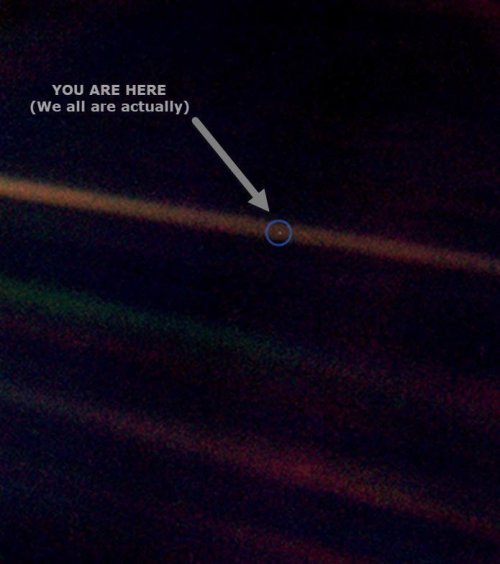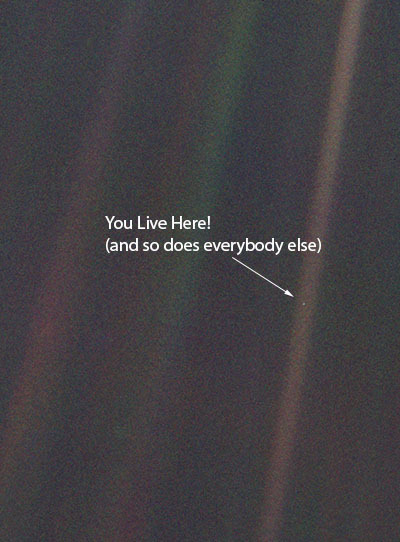NGC 7635, Bubble Nebula



NGC 7635, Bubble Nebula
More Posts from Ad-astra-affecte-spe and Others



Mars painting by Herb Herrick for an article about terraforming in World Book Science Annual 1975. Consultant: Carl Sagan. The first painting (top) is followed by two clear plastic overlays of the skies and rain and finally plant life.

Venus makes Oxygen During the Day
Ok, it's little more than an excuse to show a beautiful image of a fascinating planet, but in a recent scientific study, it was discovered in the upper atmosphere of Venus, during the day (which lasts a little longer than our day, at 243 Earth Days !!) Carbon Dioxide and Carbon Monoxide is broken down by sunlight into it's Carbon and Oxygen. The oxygen then moves around the planet, and over to the night side too, where it plays an important role in the upper atmosphere of the planet.
Amusingly, a full year on Venus is only 225 Earth days, making a day on Venus longer than a year on Venus.
I guess the upshot of this is, every day is your Birthday on Venus, so Happy Venusian Birthday to you all !

The four giant planets of our Solar System, as seen by NASA's James Webb Telescope.
this morning NASA abandoned their mars rover Opportunity (aka Oppy) because it (she) got hit by a storm on Mars and it knocked her camera and wheels out and her last words to the team were “my battery is low and it is getting cold”. I know she’s a machine but I’m devastated. Oppy is the one who discovered water on Mars. RIP oppy ily space baby

Setting Sail to Travel Through Space: 5 Things to Know about our New Mission
Our Advanced Composite Solar Sail System will launch aboard Rocket Lab’s Electron rocket from the company’s Launch Complex 1 in Māhia, New Zealand no earlier than April 23, at 6 p.m. EDT. This mission will demonstrate the use of innovative materials and structures to deploy a next-generation solar sail from a CubeSat in low Earth orbit.
Here are five things to know about this upcoming mission:
1. Sailing on Sunshine
Solar sails use the pressure of sunlight for propulsion much like sailboats harness the wind, eliminating the need for rocket fuel after the spacecraft has launched. If all goes according to plan, this technology demonstration will help us test how the solar sail shape and design work in different orbits.

2. Small Package, Big Impact
The Advanced Composite Solar Sail System spacecraft is a CubeSat the size of a microwave, but when the package inside is fully unfurled, it will measure about 860 square feet (80 square meters) which is about the size of six parking spots. Once fully deployed, it will be the biggest, functional solar sail system – capable of controlled propulsion maneuvers – to be tested in space.

3. Second NASA Solar Sail in Space
If successful, the Advanced Composite Solar Sail System will be the second NASA solar sail to deploy in space, and not only will it be much larger, but this system will also test navigation capabilities to change the spacecraft’s orbit. This will help us gather data for future missions with even larger sails.

4. BOOM: Stronger, Lighter Booms
Just like a sailboat mast supports its cloth sails, a solar sail has support beams called booms that provide structure. The Advanced Composite Solar Sail System mission’s primary objective is to deploy a new type of boom. These booms are made from flexible polymer and carbon fiber materials that are stiffer and 75% lighter than previous boom designs. They can also be flattened and rolled like a tape measure. Two booms spanning the diagonal of the square (23 feet or about 7 meters in length) could be rolled up and fit into the palm of your hand!

5. It’s a bird...it’s a plane...it’s our solar sail!
About one to two months after launch, the Advanced Composite Solar Sail System spacecraft will deploy its booms and unfurl its solar sail. Because of its large size and reflective material, the spacecraft may be visible from Earth with the naked eye if the lighting conditions and orientation are just right!
To learn more about this mission that will inform future space travel and expand our understanding of our Sun and solar system, visit https://www.nasa.gov/mission/acs3/.
Make sure to follow us on Tumblr for your regular dose of space!






The Moon
The most ridiculously detailed" image of Earth’s lunar neighbor was a two-year project captured by two astrophotographers.
The 174-megapixel image, which shows the moon’s colors, craters and glowing aura in stunning detail, was first revealed on Reddit on Saturday. Through Reddit and Instagram, Andrew McCarthy, known for his breathtaking astrophotography skills, teamed up with planetary scientist and fellow photographer Connor Matherne, who has been acclaimed for his striking and vibrant photos of galaxies and nebulae.
The two previously worked together to create an incredible glowing and detailed image of the moon.






cancel your plans we’re thinking about the pale blue dot voyager pic tonight

Moon, Jupiter and its satellites
l Josselin Desmars l France l June 14, 2023



WR 134, Cygnus
-
 tangledindream reblogged this · 2 weeks ago
tangledindream reblogged this · 2 weeks ago -
 sporadicshepherdfriendbear liked this · 1 month ago
sporadicshepherdfriendbear liked this · 1 month ago -
 princess45sworld liked this · 1 month ago
princess45sworld liked this · 1 month ago -
 devildog73 liked this · 2 months ago
devildog73 liked this · 2 months ago -
 grandescapeplan reblogged this · 2 months ago
grandescapeplan reblogged this · 2 months ago -
 ericarandour liked this · 5 months ago
ericarandour liked this · 5 months ago -
 iamnofilter liked this · 5 months ago
iamnofilter liked this · 5 months ago -
 youarenotyourblog reblogged this · 5 months ago
youarenotyourblog reblogged this · 5 months ago -
 goliardos liked this · 5 months ago
goliardos liked this · 5 months ago -
 tangledindream liked this · 6 months ago
tangledindream liked this · 6 months ago -
 youarenotyourblog reblogged this · 6 months ago
youarenotyourblog reblogged this · 6 months ago -
 rainingstatic reblogged this · 6 months ago
rainingstatic reblogged this · 6 months ago -
 imrryr liked this · 7 months ago
imrryr liked this · 7 months ago -
 solaris0310 liked this · 8 months ago
solaris0310 liked this · 8 months ago -
 souhachi reblogged this · 10 months ago
souhachi reblogged this · 10 months ago -
 ciruellas reblogged this · 10 months ago
ciruellas reblogged this · 10 months ago -
 happycuckoldress liked this · 10 months ago
happycuckoldress liked this · 10 months ago -
 silencedminstrel liked this · 11 months ago
silencedminstrel liked this · 11 months ago -
 messier47 reblogged this · 11 months ago
messier47 reblogged this · 11 months ago -
 vauseht liked this · 11 months ago
vauseht liked this · 11 months ago -
 atw211 liked this · 1 year ago
atw211 liked this · 1 year ago -
 arueinthewild reblogged this · 1 year ago
arueinthewild reblogged this · 1 year ago -
 rosakai reblogged this · 1 year ago
rosakai reblogged this · 1 year ago -
 debbi-janes liked this · 1 year ago
debbi-janes liked this · 1 year ago -
 dancingbarefootwithme reblogged this · 1 year ago
dancingbarefootwithme reblogged this · 1 year ago -
 gingernutcalo liked this · 1 year ago
gingernutcalo liked this · 1 year ago -
 david77sstuff liked this · 1 year ago
david77sstuff liked this · 1 year ago -
 j3rs3yboi liked this · 1 year ago
j3rs3yboi liked this · 1 year ago -
 blackfire2013 reblogged this · 1 year ago
blackfire2013 reblogged this · 1 year ago -
 fluffy-leech liked this · 1 year ago
fluffy-leech liked this · 1 year ago -
 autumnminaret reblogged this · 1 year ago
autumnminaret reblogged this · 1 year ago -
 autumnminaret liked this · 1 year ago
autumnminaret liked this · 1 year ago -
 anastasha-romanov reblogged this · 1 year ago
anastasha-romanov reblogged this · 1 year ago -
 aihstheta reblogged this · 1 year ago
aihstheta reblogged this · 1 year ago -
 fractalabomination liked this · 1 year ago
fractalabomination liked this · 1 year ago -
 noisypaintersong reblogged this · 1 year ago
noisypaintersong reblogged this · 1 year ago -
 mandypalmetto liked this · 1 year ago
mandypalmetto liked this · 1 year ago -
 timetravelingmachine reblogged this · 1 year ago
timetravelingmachine reblogged this · 1 year ago -
 echoloading liked this · 1 year ago
echoloading liked this · 1 year ago -
 gosh-dm-it reblogged this · 1 year ago
gosh-dm-it reblogged this · 1 year ago -
 carltonwheezerssocks reblogged this · 1 year ago
carltonwheezerssocks reblogged this · 1 year ago -
 dejavudreamer7 reblogged this · 1 year ago
dejavudreamer7 reblogged this · 1 year ago -
 eppifullofmagic reblogged this · 1 year ago
eppifullofmagic reblogged this · 1 year ago -
 thevamp114 liked this · 1 year ago
thevamp114 liked this · 1 year ago

★•Astronomy, Physics, and Aerospace•★ Original and Reblogged Content curated by a NASA Solar System Ambassador
204 posts
